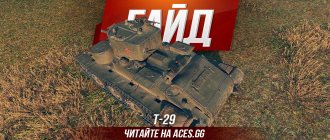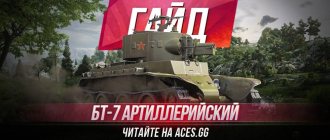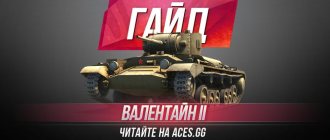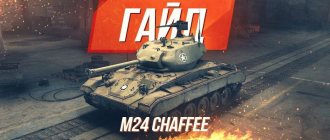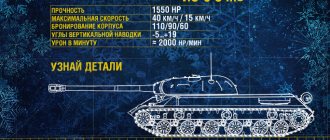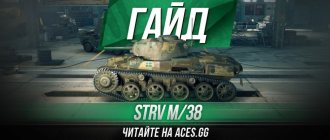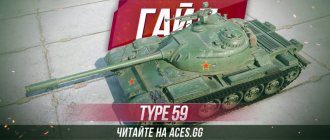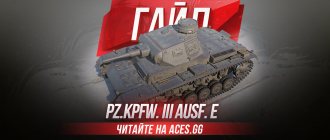Hello everyone and welcome to aces.gg! Friends, today we will focus on another representative of the sandbox, the American light premium tank of the third level - this M22 Locust guide
.
Surely many people sometimes want to take a break from intense battles using high-level equipment. Sandbox battles and M22 Locust World of Tanks
quite suitable for such purposes, but first you need to understand this machine.
TTX M22 Locust
To begin with, I would like to say that our American received a full-fledged level of fighting and at the bottom of the list we have a very hard time. I'm glad at least that by the standards of classmates the M22 Locust WoT
there is a good margin of safety and, more importantly, an excellent basic viewing range of 330 meters.
Regarding survivability, in our case there is no need to talk much about armor, however, we will still say a few words. Looking at the collage model, I would like to note that even from the forehead the M22 Locust characteristics
the reservations are very poor, but a good angle of inclination of the VLD allows you to periodically catch ricochets from classmates.
A surprisingly strong, but very small part of the tank is the gun mantlet. Here is the thickness of the M22 Locust WoT
in some places it even reaches 75 millimeters, but this area is so small in area that it would be stupid to hope for it. Otherwise, if you look at the sides and especially the stern, the thickness of the armor of this firefly is really cardboard, even machine gunners can easily penetrate us, and there is nothing to say about the battles at the bottom of the list.
True, the light tank M22 Locust
, but by its mobility. We have excellent top speed, amazing engine power-to-weight ratio and maneuverability. Using these advantages, you can rush so quickly in the sights of enemies that they will not have time to shoot at you.
By the way, another huge plus in favor of our survivability is the M22 Locust World of Tanks
has very small dimensions and the highest stealth coefficient, this also needs to be taken into account.
Forced light
The first prototype of the T9 light tank was manufactured by Marmon-Herrington by April 1942. By that time, a number of changes had been made to the design of the tank compared to the original design. Firstly, the body was now assembled mainly by welding. Only the upper front plate was bolted to provide access to the transmission. Secondly, it seemed to the American military that one machine gun paired with a cannon was not enough. As a result, the prototype received a pair of Browning M1919 machine guns installed in the front hull. The driver was trusted to shoot them, but the loader sitting in the turret had to reload them.
The tank turned out to be compact, but at the same time quite well tailored
In April of the same year, the tank was sent to Fort Benning, where sea trials took place, as well as “fitting” the T9 to the C-54 fuselage mockup. During the tests, it turned out that the chassis has insufficient rigidity. As a result, it was necessary to install first channels between the carts, and then special amplifiers. They were developed by Marmon-Herrington engineer William A. Cost. Further tests required additional intervention in the design of the tank, which slightly increased its combat weight. It is worth noting that thanks to its light weight and powerful engine, the tank turned out to be nimble. Of course, not the same as Christie’s tank, but the maximum speed of 56 km/h is a very respectable figure.
On May 31, 1942, right in the midst of the tests, a general “greetings” arrived from the American Air Force and the British. According to the updated specifications, the combat weight of the tank was supposed to be 7.1 tons, that is, 400 kg less than the previous weight mark. Just throwing away 4 centners was an extremely difficult task, since Marmon-Herrington engineers already had a strict weight limit. It became clear that something important had to be thrown away.
The first thing that went overboard was a twin installation of Browning machine guns. Probably, at this moment, the future tank loaders could breathe a sigh of relief. Next came the gyroscopic stabilizer and electric drive of the tower. Of course, it was much better with them, but you can still live without a stabilizer and an electric drive. After being lightened, the prototype of the T9 light tank continued testing, which ended only in January 1943. This machine was later used at Marmon-Herrington as a running stand.
Light Tank T9E1, Aberdeen Proving Ground, December 1942. It is clearly noticeable that the body of the car has been heavily altered
Back in February 1942, work began on creating an improved version of the T9 tank. In April, a full-size mock-up of the tank, designated Light Tank T9E1, was sent to Fort Benning and tested under a C-54 fuselage mock-up. As a result of these tests, the hull was seriously redesigned, in which the influence of the T7 light tank, or more precisely the T7E2, was again clearly visible. The frontal sheet began to consist of one part located at a large angle of inclination.
Other parts of the hull, especially the stern, were also redesigned. A separate wheelhouse appeared on the driver's hatch, which improved visibility. The design of the tower has changed, which instead of one large hatch received two smaller ones.
In this form, the Light Tank T9E1 was suspended under the fuselage of a Douglas C-54 Skymaster military transport aircraft
The first prototype of the T9E1 light tank was manufactured in November 1942, and intensive testing began at the same time. The second car was sent to England immediately after construction for review and testing. Apparently, both sides were satisfied: serial production of the Light Tank T9E1 began in April 1943. In total, until February 1944, Marmon-Herrington produced 830 tanks of this type. This was the biggest success for the Indianapolis company in the field of tank building.
The designation Light Tank T9E1 was used for this tank until September 1944, when the vehicle was finally standardized as the Light Tank M22. As for Great Britain, there this tank received the designation Locust, that is, “locust”. The brainchild of Marmon-Herrington was not called “M22 Locust” - this is akin to calling the famous American medium tank “M4 Sherman”. Here M4 Medium Tank is the American designation, and Sherman I is the English designation.
In 1944, an alternative for air transport of the Light Tank M22 appeared in the form of the Fairchild C-82 Packet. The entire Light Tank T9E1 fit into it
With the start of mass production, work on the T9E1 did not end. In November 1943, a program was launched to install an 81-mm T24E1 breech-loading mortar into the turret. In August 1944, one T9E1 was equipped with such a mortar. The vehicle received the designation Light Tank T9E2. However, the matter did not progress further than experiments.
gun
It's time to talk about how good our American is at dealing damage and now we will look at his weapons, because this is the most important part of any tank.
M22 Locust gun
cannot boast of much damage, since our alphastrike is quite small and even with a good rate of fire, we are only capable of delivering about 1050 units of damage per minute.
As for the armor penetration parameters, they are good enough to comfortably fight with vehicles of their level. However, for battles at the bottom of the list is the M22 Locust tank
must replenish his already small ammunition load with gold shells, although even this will help little against levels 5.
In terms of accuracy, the situation is quite typical for low-level technology. This unit has a large spread, our gun is poorly stabilized, but the good aiming speed almost completely compensates for these shortcomings. By the way, the light tank M22 Locust World of Tanks
has excellent elevation angles, the gun lowers by 10 degrees.
Historical reference
M22 Locust (Locust) - US light tank. Produced until the mid-40s of the 20th century. About 830 vehicles were produced.
The small and light vehicle had to have great air mobility - the ability to be transported by transport aircraft.
It was not used by the US Army in actual combat.
More than 2 hundred M22 were transferred to Great Britain. Where they took part in one landing operation. Has proven itself to be a good support vehicle.
Advantages and disadvantages
Oddly enough, we have a really strong machine in our hands, but it requires a special approach. To realize the potential of the M22 Locust WoT
, it is necessary to have a clear understanding of its advantages and disadvantages, so it is time to highlight them separately. Pros: • Small tank size; • Very good stealth; • Excellent mobility; • Good overview; • Comfortable vertical aiming angles; • Good accuracy. Cons: • Full level of battles; • Weak armor; • Small ammunition; • Weak DPM; • Insufficient penetration for fights at the bottom of the list.
Equipment for M22 Locust
Of course, in order to play a tank with the greatest comfort, realize its strengths, and also level out its weaknesses, it is important to choose the right additional modules. In the case of M22 Locust equipment
The following is stated: 1. – an excellent choice that will give us an increase in very important characteristics. 2. – we already have a good overview, and with this module we will get an excellent advantage over many of our classmates, perhaps even on par with some level 5 machines. 3. – among all the possible options, this one looks the most advantageous, and the process of dealing damage will become even more comfortable.
By the way, it makes sense to change tactics and make a real firefly out of our tank, which is most effective in battles against the fifth levels, where we can hardly penetrate anyone. So, another variation with equipment for the M22 Locust World of Tanks
implies replacement of points 2 and 3: 4. – we will increase our visibility even more, which will make it possible to overexpose even many level 5 vehicles. 5. – if we add this module to our excellent camouflage, spotting us will be an incredibly difficult task, while we are delivering precious intelligence.
Of course, the second set implies a certain, passive style of play, but this tactic also gives very good results.
Strictly according to specification
Back in May 1941, when the specifications for the T9 airborne tank were being created, the Armament Directorate decided to play it safe. In parallel with Christie, the Marmon-Herrington Company, Inc. received the task of developing an airborne tank. and Pontiac, one of the divisions of the automobile giant General Motors. Pontiac in this case was rather considered as the last option, since the automaker had no experience in tank building. As for Marmon-Herrington, by 1941 it already had a substantial baggage in the form of wedges, armored cars and light tanks, which were mass-produced and even saw war.
Christie's alternative is the Light Tank T9 developed by Marmon-Herrington. A wooden model of the tank was presented already in August 1941
A full-size mock-up of the Light Tank T9 was presented in August 1941. Marmon-Herrington did not invent a bicycle and took the CTLS light tank as a basis. Almost the entire chassis was borrowed from the original car, with the exception of the sloth wheels. Externally, the new vehicle resembled the T7 light tank, which was being designed at that time by the Rock Island Arsenal.
This similarity is clearly not accidental, since the further evolution of both machines took place in a very similar way. The vehicle received a riveted hull of the traditional shape for American light tanks, with the difference that due to the size limit it turned out to be very small. It was planned to install a cast two-man turret on the tank, similar in design to the one installed on the M3 medium tank. It was planned to install a 37-mm cannon and a coaxial Browning M1919 machine gun as weapons.
The vehicle was inspected not only by representatives of the Armaments Directorate, but also by representatives of the US Air Force, as well as engineers from the Douglas company. The latter did not appear by chance. As already mentioned, the C-54 military transport aircraft, which was being developed by Douglas, was supposed to be used as a carrier aircraft for the new tank. Overall, everyone was happy with the car. In November, a full-size mock-up was produced for Douglas to fit the C-54. The tank was suspended under the fuselage of the aircraft. The tower was dismantled and loaded inside. The mass of the turret was relatively small, so loading it inside the cabin did not present much of a problem.
Light Tank T9 concept from Pontiac
Competitor Pontiac presented its vision of an airborne tank in September 1941. In general, the Pontiac tank was similar to the Marmon-Herrington tank. The difference was in the design features of the hull and the power plant. The body was supposed to be welded using casting. The power plant was supposed to use a pair of 6-cylinder Pontiac automobile engines with a volume of 3.9 liters and a power of 90 horsepower each. For comparison, the Marmon-Herrington tank was supposed to be equipped with a tank version of the Lycoming O-435T 7-liter boxer aircraft engine. This engine was put into production just in 1942.
The tanks turned out to be very similar to each other, and the main argument for choice was the price. The Marmon-Herrington project turned out to be cheaper, which was the main reason for the victory of the tank from the Indianapolis company.
Prototype Light Tank T9, April 1942. To prevent the driver from getting bored, he was given a coaxial installation of forward machine guns
The management of General Motors, however, was not particularly upset, since it was planned to build a self-propelled unit on the basis of the T9. The car, which received the T42 GMC index, evolved into the T49 GMC. From that moment on, it was handled by another division of General Motors - Buick. The result of the development was the T70 GMC, also known as the M18 Hellcat.
Tactics for playing the M22 Locust
Despite the fact that we have no armor, a small safety margin, and with all this, we often have to fight against levels 4-5, this LT is really capable of a lot in the right hands, the main thing is to use its strengths correctly.
So, for the M22 Locust tactics
Combat is primarily about making effective use of our camouflage and vision. In battles against fives, we can deliver intelligence, which is very useful for the team, and also gives us additional experience and silver.
You can do the same thing while at the top, but just standing in the bushes is boring. Light tank M22 Locust WoT
has such a high stealth coefficient that it can shoot from bushes without being exposed, of course, if the enemy does not drive up close to us. Thanks to this skill and residual good accuracy, you can very well implement your small DPM, taking with you a lot of damage and enemy scalps.
Don't forget that we have amazing mobility at our disposal. This is the advantage of M22 Locust World of Tanks
can be used not only for reconnaissance. We are able to spin slow opponents, change directions of attack or flanks in the shortest possible time in order to attack the enemy from an unexpected direction.
To summarize, I want to say that our American is really capable of a lot, all he needs is a creative approach and considerable gaming experience. Remember that you should always monitor the mini-map, beware of land mines and also, at the fifth level there are vehicles that are M22 Locust tank
We can’t even break through with gold, we should be wary of such opponents.
